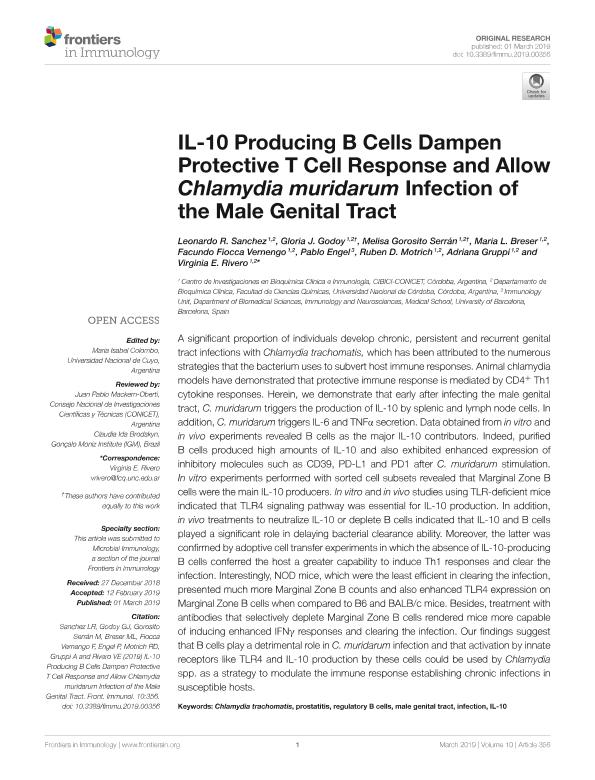Mostrar el registro sencillo del ítem
dc.contributor.author
Sanchez, Leonardo Rodolfo

dc.contributor.author
Godoy, Gloria Janet

dc.contributor.author
Gorosito Serran, Melisa

dc.contributor.author
Breser, Maria Laura

dc.contributor.author
Fiocca Vernengo, Facundo

dc.contributor.author
Mengelle, Pablo

dc.contributor.author
Motrich, Ruben Dario

dc.contributor.author
Gruppi, Adriana

dc.contributor.author
Rivero, Virginia Elena

dc.date.available
2020-08-31T14:08:44Z
dc.date.issued
2019-03
dc.identifier.citation
Sanchez, Leonardo Rodolfo; Godoy, Gloria Janet; Gorosito Serran, Melisa; Breser, Maria Laura; Fiocca Vernengo, Facundo; et al.; IL-10 producing B cells dampen protective T cell response and allow chlamydia muridarum infection of the male genital tract; Frontiers Media S.A.; Frontiers in Immunology; 10; 3-2019
dc.identifier.uri
http://hdl.handle.net/11336/112709
dc.description.abstract
A significant proportion of individuals develop chronic, persistent and recurrent genital tract infections with Chlamydia trachomatis, which has been attributed to the numerous strategies that the bacterium uses to subvert host immune responses. Animal chlamydia models have demonstrated that protective immune response is mediated by CD4+ Th1 cytokine responses. Herein, we demonstrate that early after infecting the male genital tract, C. muridarum triggers the production of IL-10 by splenic and lymph node cells. In addition, C. muridarum triggers IL-6 and TNFα secretion. Data obtained from in vitro and in vivo experiments revealed B cells as the major IL-10 contributors. Indeed, purified B cells produced high amounts of IL-10 and also exhibited enhanced expression of inhibitory molecules such as CD39, PD-L1 and PD1 after C. muridarum stimulation. In vitro experiments performed with sorted cell subsets revealed that Marginal Zone B cells were the main IL-10 producers. In vitro and in vivo studies using TLR-deficient mice indicated that TLR4 signaling pathway was essential for IL-10 production. In addition, in vivo treatments to neutralize IL-10 or deplete B cells indicated that IL-10 and B cells played a significant role in delaying bacterial clearance ability. Moreover, the latter was confirmed by adoptive cell transfer experiments in which the absence of IL-10-producing B cells conferred the host a greater capability to induce Th1 responses and clear the infection. Interestingly, NOD mice, which were the least efficient in clearing the infection, presented much more Marginal Zone B counts and also enhanced TLR4 expression on Marginal Zone B cells when compared to B6 and BALB/c mice. Besides, treatment with antibodies that selectively deplete Marginal Zone B cells rendered mice more capable of inducing enhanced IFNγ responses and clearing the infection. Our findings suggest that B cells play a detrimental role in C. muridarum infection and that activation by innate receptors like TLR4 and IL-10 production by these cells could be used by Chlamydia spp. as a strategy to modulate the immune response establishing chronic infections in susceptible hosts.
dc.format
application/pdf
dc.language.iso
eng
dc.publisher
Frontiers Media S.A.

dc.rights
info:eu-repo/semantics/openAccess
dc.rights.uri
https://creativecommons.org/licenses/by-nc-sa/2.5/ar/
dc.subject
CHLAMYDIA TRACHOMATIS
dc.subject
IL-10
dc.subject
INFECTION
dc.subject
MALE GENITAL TRACT
dc.subject
PROSTATITIS
dc.subject
REGULATORY B CELLS
dc.subject.classification
Inmunología

dc.subject.classification
Medicina Básica

dc.subject.classification
CIENCIAS MÉDICAS Y DE LA SALUD

dc.title
IL-10 producing B cells dampen protective T cell response and allow chlamydia muridarum infection of the male genital tract
dc.type
info:eu-repo/semantics/article
dc.type
info:ar-repo/semantics/artículo
dc.type
info:eu-repo/semantics/publishedVersion
dc.date.updated
2020-08-20T20:25:59Z
dc.identifier.eissn
1664-3224
dc.journal.volume
10
dc.journal.pais
Estados Unidos

dc.description.fil
Fil: Sanchez, Leonardo Rodolfo. Universidad Nacional de Córdoba; Argentina. Consejo Nacional de Investigaciones Científicas y Técnicas. Centro Científico Tecnológico Córdoba. Centro de Investigaciones en Bioquímica Clínica e Inmunología; Argentina
dc.description.fil
Fil: Godoy, Gloria Janet. Universidad Nacional de Córdoba; Argentina. Consejo Nacional de Investigaciones Científicas y Técnicas. Centro Científico Tecnológico Córdoba. Centro de Investigaciones en Bioquímica Clínica e Inmunología; Argentina
dc.description.fil
Fil: Gorosito Serran, Melisa. Universidad Nacional de Córdoba; Argentina. Consejo Nacional de Investigaciones Científicas y Técnicas. Centro Científico Tecnológico Córdoba. Centro de Investigaciones en Bioquímica Clínica e Inmunología; Argentina
dc.description.fil
Fil: Breser, Maria Laura. Universidad Nacional de Córdoba; Argentina. Consejo Nacional de Investigaciones Científicas y Técnicas. Centro Científico Tecnológico Conicet - Córdoba. Centro de Investigaciones y Transferencia de Villa María. Universidad Nacional de Villa María. Centro de Investigaciones y Transferencia de Villa María; Argentina
dc.description.fil
Fil: Fiocca Vernengo, Facundo. Universidad Nacional de Córdoba; Argentina. Consejo Nacional de Investigaciones Científicas y Técnicas. Centro Científico Tecnológico Córdoba. Centro de Investigaciones en Bioquímica Clínica e Inmunología; Argentina
dc.description.fil
Fil: Mengelle, Pablo. Universidad de Barcelona; España
dc.description.fil
Fil: Motrich, Ruben Dario. Universidad Nacional de Córdoba; Argentina. Consejo Nacional de Investigaciones Científicas y Técnicas. Centro Científico Tecnológico Córdoba. Centro de Investigaciones en Bioquímica Clínica e Inmunología; Argentina
dc.description.fil
Fil: Gruppi, Adriana. Universidad Nacional de Córdoba; Argentina. Consejo Nacional de Investigaciones Científicas y Técnicas. Centro Científico Tecnológico Córdoba. Centro de Investigaciones en Bioquímica Clínica e Inmunología; Argentina
dc.description.fil
Fil: Rivero, Virginia Elena. Universidad Nacional de Córdoba; Argentina. Consejo Nacional de Investigaciones Científicas y Técnicas. Centro Científico Tecnológico Córdoba. Centro de Investigaciones en Bioquímica Clínica e Inmunología; Argentina
dc.journal.title
Frontiers in Immunology
dc.relation.alternativeid
info:eu-repo/semantics/altIdentifier/url/https://www.frontiersin.org/articles/10.3389/fimmu.2019.00356/full
dc.relation.alternativeid
info:eu-repo/semantics/altIdentifier/doi/https://doi.org/10.3389/fimmu.2019.00356
Archivos asociados
